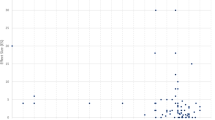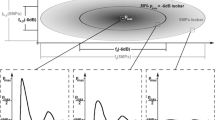Abstract
Millimetre wave (MMW) and THz wave (THz) applications are already employed in certain industrial and medical environments for non-destructive quality control, and medical imaging, diagnosis, and therapy, respectively. The aim of the present study is to investigate if published experimental studies (in vivo and in vitro) provide evidence for “non-thermal” biological effects of MMW and THz. Such effects would occur in absence of tissue heating and associated damage and are the ones that can be exploited for therapeutic medical use. The investigated studies provide some evidence for both MMW and THz that can influence biological systems in a manner that is not obviously driven by tissue heating. However, the number of relevant studies is very limited which severely limits the drawing of any far-reaching conclusions. Furthermore, the studies have not addressed specific interaction mechanisms and do not provide hints for future mechanistic studies. Also, the studies do not indicate any specific importance regarding power density levels, frequencies, or exposure duration. It is also unclear if any specific biological endpoints are especially sensitive. Any therapeutic potential of MMW or THz has to be evaluated based on future high-quality studies dealing with physical, bio-physical, and biological aspects that have specific health-related perspectives in mind.




Similar content being viewed by others
References
M. C. Ziskin, ‘Millimeter waves: acoustic and electromagnetic.’, Bioelectromagnetics, vol. 34, no. 1, pp. 3–14, Jan. 2013.
K. Humphreys et al., ‘Medical applications of terahertz imaging: a review of current technology and potential applications in biomedical engineering.’, Conf. Proc. IEEE Eng. Med. Biol. Soc., vol. 2, pp. 1302–1305, 2004.
C. Yu, S. Fan, Y. Sun, and E. Pickwell-Macpherson, ‘The potential of terahertz imaging for cancer diagnosis: A review of investigations to date’, Quatitative Imaging Med. Surg., vol. 2, no. 1, pp. 33–45, Mar. 2012.
L. V Titova et al., ‘Intense THz pulses down-regulate genes associated with skin cancer and psoriasis: a new therapeutic avenue?’, Sci. Rep., vol. 3, p. 2363, 2013.
T. T. L. Kristensen, W. Withayachumnankul, P. U. Jepsen, and D. Abbott, ‘Modeling terahertz heating effects on water.’, Opt. Express, vol. 18, no. 5, pp. 4727–4739, 2010.
O. P. Cherkasova, V. I. Fedorov, E. F. Nemova, and A. S. Pogodin, ‘Influence of terahertz laser radiation on the spectral characteristics and functional properties of albumin’, Opt. Spectrosc., vol. 107, no. 4, pp. 534–537, 2009.
B. S. Alexandrov, V. Gelev, A. R. Bishop, A. Usheva, and K. Rasmussen, ‘DNA breathing dynamics in the presence of a terahertz field’, Phys. Lett. Sect. A Gen. At. Solid State Phys., vol. 374, no. 10, pp. 1214–1217, 2010.
Y. Le Dréan et al., ‘State of knowledge on biological effects at 40-60 GHz’, Comptes Rendus Phys., vol. 14, no. 5, pp. 402–411, 2013.
M. K. Logani, A. Bhanushali, A. Anga, A. Majmundar, I. Szabo, and M. C. Ziskin, ‘Combined millimeter wave and cyclophosphamide therapy of an experimental murine melanoma’, Bioelectromagnetics, vol. 25, no. 7, pp. 516–523, 2004.
M. K. Logani, I. Szabo, V. Makar, A. Bhanushali, S. Alekseev, and M. C. Ziskin, ‘Effect of millimeter wave irradiation on tumor metastasis’, Bioelectromagnetics, vol. 27, no. 4, pp. 258–264, 2006.
T. I. Usichenko, O. I. Ivashkivsky, and V. V Gizhko, ‘Treatment of rheumatoid arthritis with electromagnetic millimeter waves applied to acupuncture points—a randomized double blind clinical study.’, Acupunct. Electrother. Res., vol. 28, no. 1–2, pp. 11–18, 2003.
A. A. Radzievsky, O. V. Gordiienko, S. Alekseev, I. Szabo, A. Cowan, and M. C. Ziskin, ‘Electromagnetic millimeter wave induced hypoalgesia: Frequency dependence and involvement of endogenous opioids’, Bioelectromagnetics, vol. 29, no. 4, pp. 284–295, May 2008.
M. K. Logani, M. K. Bhopale, and M. C. Ziskin, ‘Millimeter Wave and Drug Induced Modulation of the Immune System—Application in Cancer Immunotherapy’, J. Cell Sci. Ther., vol. s5, no. S5, 2012.
A. A. Radzievsky, M. A. Rojavin, A. Cowan, S. I. Alekseev, A. A. Radzievsky, and M. C. Ziskin, ‘Peripheral neural system involvement in hypoalgesic effect of electromagnetic millimeter waves’, Life Sci., vol. 68, no. 10, pp. 1143–1151, 2001.
T. I. Usichenko, H. Edinger, V. V. Gizhko, C. Lehmann, M. Wendt, and F. Feyerherd, ‘Low-intensity electromagnetic millimeter waves for pain therapy’, Evidence-based Complementary and Alternative Medicine, vol. 3, no. 2. pp. 201–207, 2006.
T. Partyla, H. Hacker, H. Edinger, B. Leutzow, J. Lange, and T. Usichenko, ‘Remote Effects of Electromagnetic Millimeter Waves on Experimentally Induced Cold Pain: A Double-Blinded Crossover Investigation in Healthy Volunteers’, Anesth. Analg., vol. 124, no. 3, pp. 980–985, 2017.
A. Y. Owda et al., ‘Millimeter-wave emissivity as a metric for the non-contact diagnosis of human skin conditions.’, Bioelectromagnetics, vol. 38, no. 7, pp. 559–569, Oct. 2017.
P. Tewari et al., ‘In vivo terahertz imaging of rat skin burns’, J. Biomed. Opt., vol. 17, no. 4, p. 40503, 2012.
H. Chen et al., ‘High-sensitivity in vivo THz transmission imaging of early human breast cancer in a subcutaneous xenograft mouse model’, Opt. Express, vol. 19, no. 22, p. 21552, 2011.
S. Sy et al., ‘Terahertz spectroscopy of liver cirrhosis: Investigating the origin of contrast’, Phys. Med. Biol., vol. 55, no. 24, pp. 7587–7596, 2010.
S. J. Oh et al., ‘Study of freshly excised brain tissues using terahertz imaging’, Biomed. Opt. Express, vol. 5, no. 8, p. 2837, 2014.
X. Yang et al., ‘Biomedical Applications of Terahertz Spectroscopy and Imaging.’, Trends Biotechnol., vol. 34, no. 10, pp. 810–24, Oct. 2016.
V. I. Fedorov, ‘The biological effects of terahertz laser radiation as a fundamental premise for designing diagnostic and treatment methods’, Biophysics (Oxf)., vol. 62, no. 2, pp. 324–330, 2017.
M. Wang, G. Yang, W. Li, and Q. Wu, ‘An overview of cancer treatment by terahertz radiation’, in 2013 I.E. MTT-S International Microwave Workshop Series on RF and Wireless Technologies for Biomedical and Healthcare Applications, IMWS-BIO 2013-Proceedings, 2013.
I. Echchgadda et al., ‘Terahertz Radiation: A Non-contact Tool for the Selective Stimulation of Biological Responses in Human Cells’, IEEE Trans. Terahertz Sci. Technol., vol. 6, no. 1, pp. 54–68, 2016.
M. Simkó, D. Remondini, O. Zeni, and M. R. Scarfi, ‘Quality Matters: Systematic Analysis of Endpoints Related to “Cellular Life” in Vitro Data of Radiofrequency Electromagnetic Field Exposure’, Int. J. Environ. Res. Public Health, vol. 13, no. 7, p. 701, Jul. 2016.
C. K. Chou et al., ‘Radio frequency electromagnetic exposure: tutorial review on experimental dosimetry.’, Bioelectromagnetics, vol. 17, no. 3, pp. 195–208, 1996.
N. Kuster and F. Schönborn, ‘Recommended minimal requirements and development guidelines for exposure setups of bio-experiments addressing the health risk concern of wireless communications.’, Bioelectromagnetics, vol. 21, no. 7, pp. 508–14, 2000.
J. Schilderet, D. Spät, T. Samaras, W. Oesch, and N. Kuster, ‘In vitro exposure systems for RF exposures at 900 MHz’, IEEE Trans. Microw. Theory Tech., vol. 52, no. 8 II, pp. 2067–2075, 2004.
A. Paffi et al., ‘Considerations for developing an RF exposure system: A review for in vitro biological experiments’, IEEE Trans. Microw. Theory Tech., vol. 58, no. 10, pp. 2702–2714, 2010.
O. Zeni and M. R. Scarfì, ‘Experimental requirements for in vitro studies aimed to evaluate the biological effects of radiofrequency radiation’, Microw. Mater. Charact., pp. 121–138, Nov. 2012.
International Commission on Non-Ionizing Radiation Protection (ICNIRP), ‘ICNIRP Guidelines for Limiting Exposure To Time-Varying Electric, Magnetic and Electromagnetic fields’, Health Phys., vol. 74, pp. 494–522, 1998.
J. F. Federici et al., ‘THz imaging and sensing for security applications - Explosives, weapons and drugs’, Semiconductor Science and Technology, vol. 20, no. 7. 2005.
J. Federici and L. Moeller, ‘Review of terahertz and subterahertz wireless communications’, Journal of Applied Physics, vol. 107, no. 11. 2010.
E. Berry, ‘Risk perception and safety issues’, in Journal of Biological Physics, 2003, vol. 29, no. 2–3, pp. 263–267.
M. Saviz, O. Spathmann, J. Streckert, V. Hansen, M. Clemens, and R. Faraji-Dana, ‘Theoretical estimations of safety thresholds for terahertz exposure of surface tissues’, IEEE Trans. Terahertz Sci. Technol., vol. 3, no. 5, pp. 635–640, 2013.
International Commission on Non-Ionizing Radiation Protection (ICNIRP), ‘Guidelines on UV radiation exposure limits.’, Health Phys., vol. 71, no. 6, p. 978, Dec. 1996.
M. Mattsson and M. Simkó, ‘Grouping of Experimental Conditions as an Approach to Evaluate Effects of Extremely Low-Frequency Magnetic Fields on Oxidative Response in in vitro Studies.’, Front. public Heal., vol. 2, no. September, p. 132, 2014.
Funding
MS and MOM received a financial support from Forschungsstiftung Strom und Mobilkommunikation, CH (FSM; Project B2014-04). MOM received intramural funding from AIT for parts of this study.
Author information
Authors and Affiliations
Corresponding author
Electronic Supplementary Material
ESM 1
(DOCX 212 kb)
Rights and permissions
About this article
Cite this article
Mattsson, MO., Zeni, O. & Simkó, M. Is there a Biological Basis for Therapeutic Applications of Millimetre Waves and THz Waves?. J Infrared Milli Terahz Waves 39, 863–878 (2018). https://doi.org/10.1007/s10762-018-0483-5
Received:
Accepted:
Published:
Issue Date:
DOI: https://doi.org/10.1007/s10762-018-0483-5




